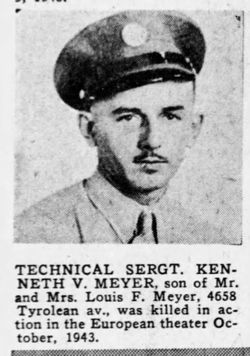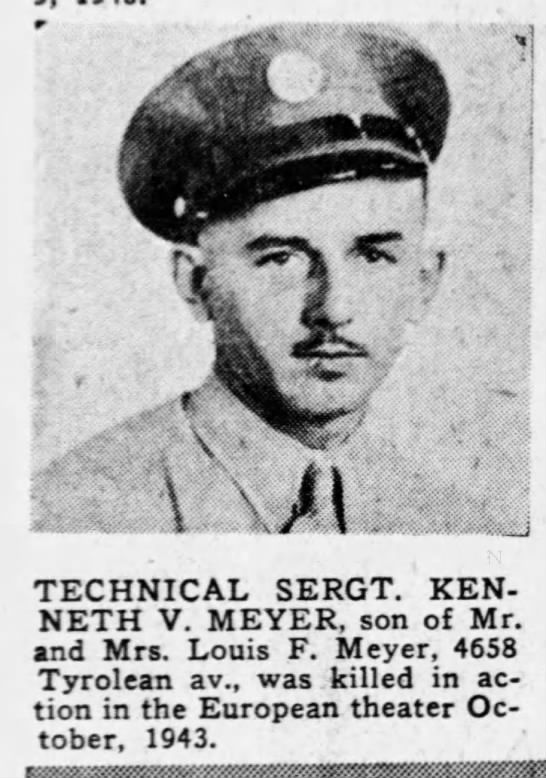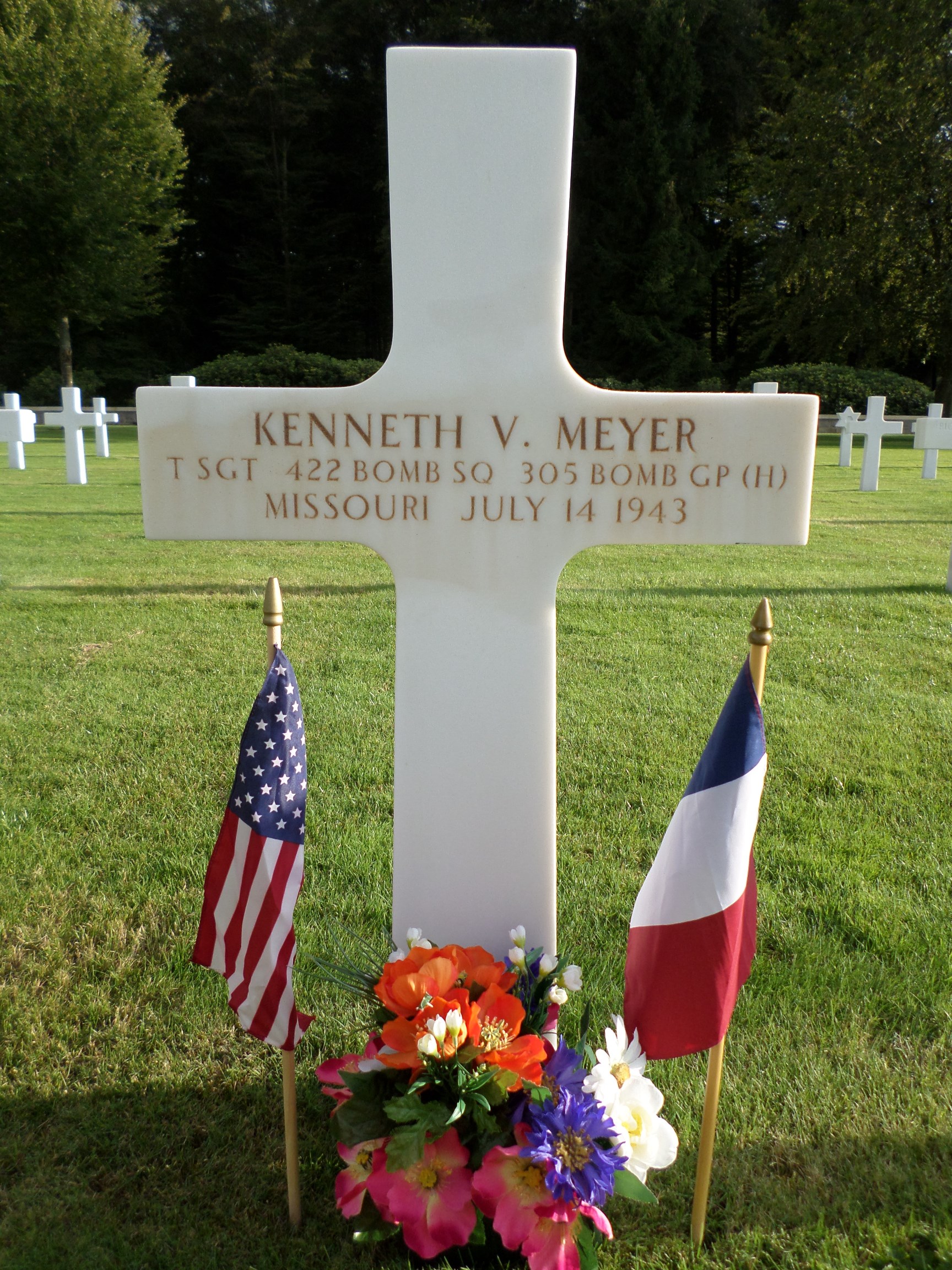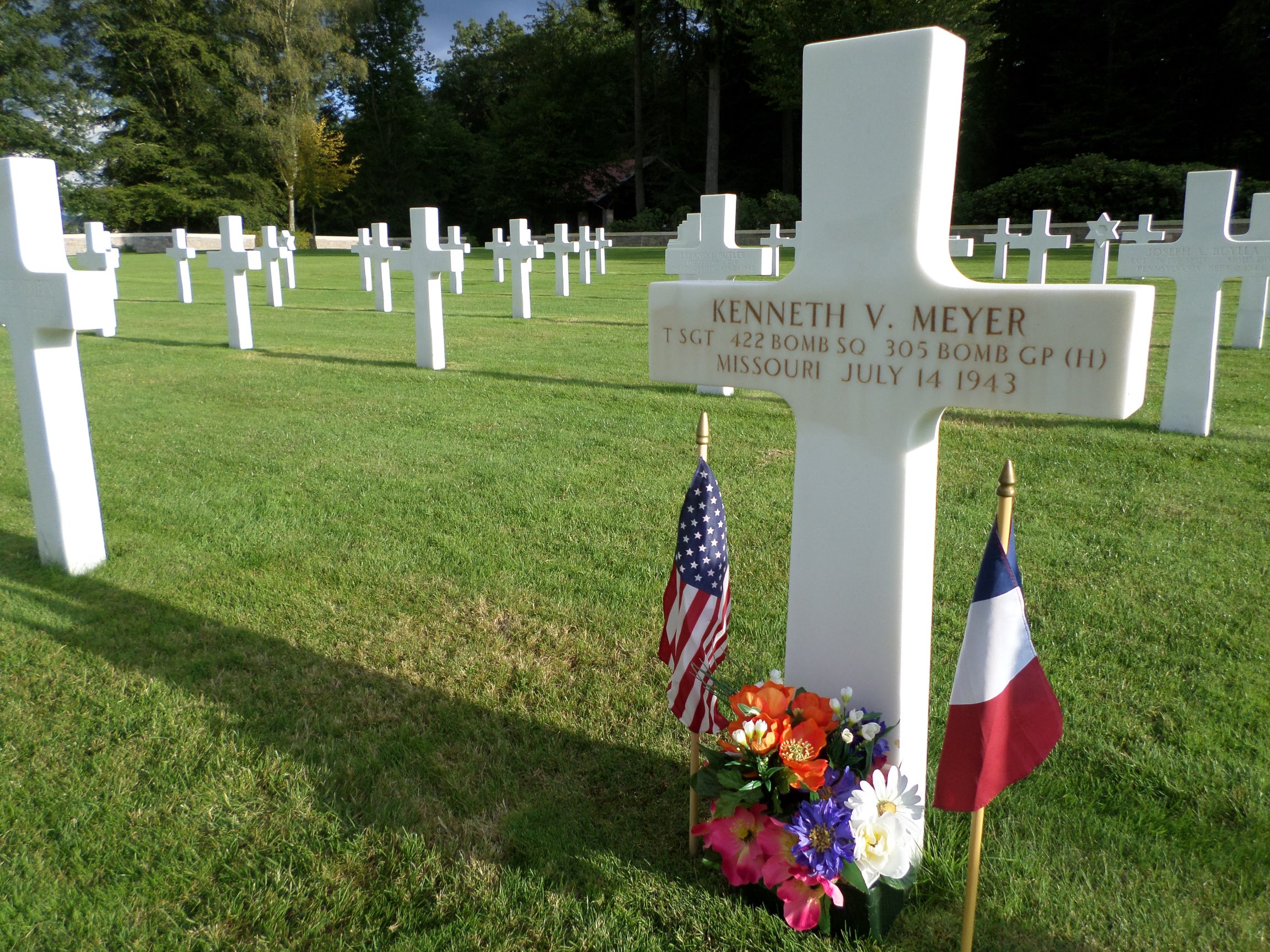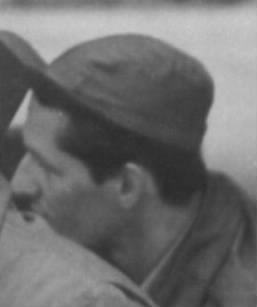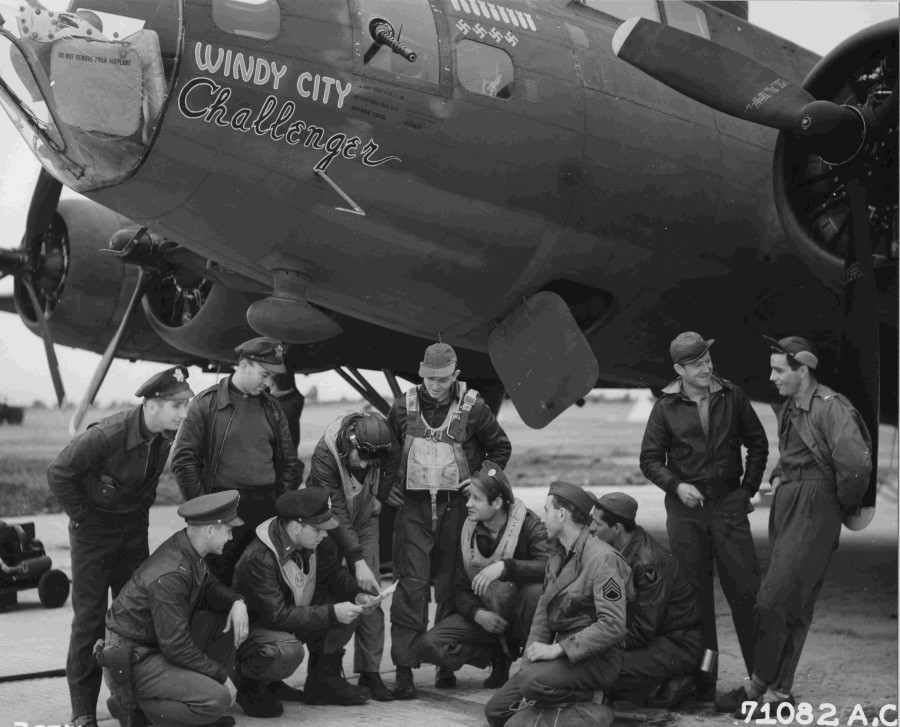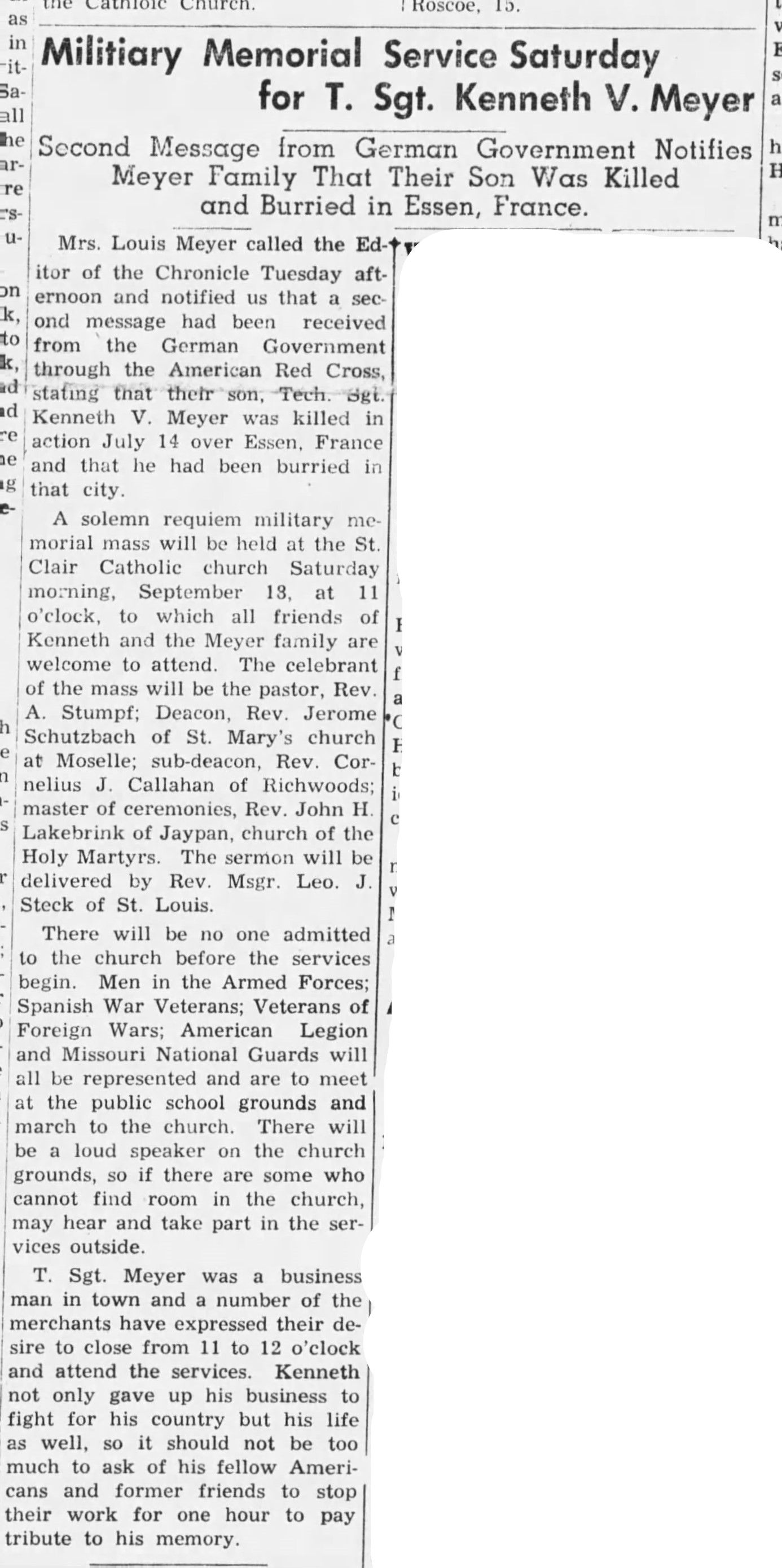Kenneth operated an auto repair shop and service station in St. Clair, MO, before enlisting at the age of 26. His parents had previously owned a restaurant in St. Clair but later moved to St. Louis. Kenneth's parents were notified in September that the German government had notified the Red Cross that Kenneth had been killed.
He was awarded the "Silver Star", Air Medal with 3 Oak Leaf Clusters and the Purple Heart.
Kenneth barely escaped death earlier. On May 15, 1943, while serving as tail gunner B-17 42-29673 / Old Bill, Kenneth assisted in saving the plane from severe battle damage. Among a crew of 11, he and one other airman were the only ones uninjured. George H. Friend was also on the "Old Bill" flight. Below is a detailed description of that flight by John L. Frisbee June 1, 1993:
Valor: Ordeal for the Record by John L. Frisbee, June 1, 1993. On May 15, 1943, the 305th Bomb Group was dispatched from its base at Chelveston, UK, as part of a strike force against military installations near Wilhelmshaven on Germany’s northwest coast. The 305th was one of the earliest B-17 groups to arrive in England, flying its first combat mission on Nov. 17, 1942. Under the leadership of Col. Curtis LeMay, the group had risen from the status of combat novices to one of the premier veteran outfits. It had been a costly, often painful learning process.
Old Bill, a B-17 from the group’s 365th Squadron, was piloted by Lt. Bill Whitson on the Wilhelmshaven mission. Whitson knew that neither the AAF nor the RAF had fighters with enough range for escort into Germany. Enemy fighter attacks were inevitable as the squadron approached the target. Some distance short of Wilhelmshaven, bombardier Lt. Robert Barrall reported that the target area was blanketed with clouds. The group would proceed north to the island of Heligoland, an alternative that would not be uncontested. Already there were contrails several thousand feet above them. Seconds later, a swarm of FW-190s launched a head-on attack.
Closing at nearly 600 miles an hour, the FW-190s raked Old Bill with 20-mm cannon fire. Shell fragments cut deep into Whitson’s legs and severed oxygen lines to the flight deck. Dragging himself painfully from his seat, Whitson staggered to the rear of the aircraft to assess damage and gather walkaround oxygen bottles. When he returned to the cockpit, copilot Lt. Harry Holt was suffering from severe anoxia. A revived Holt took over while Whitson’s wounds were being cared for.
Returning to the left seat, Lieutenant Whitson was able, with difficulty, to hold formation as fighter attacks continued. The FW-190s concentrated on Whitson’s bomber, which clearly was in trouble. Another 20-mm shell exploded in the cockpit, fragments hitting the injured pilot and wounding Lieutenant Holt so seriously he could no longer help control the B-17 and had to be carried from his seat.
Almost immediately, 20-mm shells tore the Plexiglas nose completely away, killing navigator Lt. Douglas Venable and wounding bombardier Barrall. The top turret was shattered, leaving Sgt. Albert Haymon bleeding from head and arm injuries. Haymon stayed in the useless turret, hand-cranking the silent guns to a forward position that might discourage Luftwaffe fighter pilots. He then climbed down to help wounded radio operator Sgt. Fred Bewak.
With one engine out, a wing buckled, and hydraulics gone, Whitson could no longer stay with the formation. Checking with the crew, he found only two of his men uninjured. Those gunners whose weapons were still operating continued firing at enemy fighters as Whitson dove for cloud cover 5,000 feet below. The gunners claimed seven fighters destroyed during that screaming descent.
Exhausted from loss of blood and the strain of evasive maneuvers, Whitson was barely conscious. Seeing the pilot’s condition, Sergeant Haymon slid into the copilot’s seat and flew the plane while Whitson regained some strength.
When the bomber broke out of the clouds, Haymon saw an ME-210 peeling off to attack Old Bill and alerted the crew. Twice-wounded, Lieutenant Barrall climbed into the shattered nose section and manned the cheek gun, buffeted by a 150-mile-an-hour wind that blasted in through the open nose. Barrall kept firing until one of the -210’s engines exploded and the enemy plane plunged into the sea. He then climbed up to the flight deck and relieved Whitson, who would have to land the plane if they made it to Chelveston. Tailgunner Sgt. Kenneth Meyer, one of the two uninjured crew members, replaced Sergeant Haymon in the copilot’s seat. He and Barrall managed to maneuver the stricken bomber into the protection of a formation of B-17s returning to England.
Once they reached the coast, they were on their own. With a dead navigator, a copilot out of action, a wounded radio operator, and a barely conscious pilot, finding Chelveston among the welter of airfields dotting the Midlands was no small achievement. As they approached the field, Whitson took over the controls, shaking his head to clear his brain and retain consciousness. Because the plane lacked flaps and brakes, he flew the B-17 onto the runway far above normal landing speed and ground-looped when it ran out of runway. He then collapsed over the control column. No 305th B-17 had ever survived such a beating. It had been an ordeal for the record. Lieutenants Whitson and Barrall were awarded the Distinguished Service Cross, all other crew members the Silver Star, and eight of the 10, the Purple Heart to become the most decorated crew of the 305th Bomber Group.
Service # 16019182
-------------------------
Airmen who perished on B-17F (#42-3049):
Devine, Joseph F ~ S/Sgt, Left Waist Gunner, Connecticut
Dube, Joseph L P ~ T/Sgt, Top Turret Gunner, New Hampshire
Lesneau, Sidney J ~ S/Sgt, Right Waist Gunner, Minnesota
Lewis, Arthur C ~ 1st Lt, Co-Pilot, Arizona
Meyer, Kenneth V ~ T/Sgt, Tail Gunner, Missouri
Perkins, John H, Jr ~ 1st Lt, Pilot, Illinois
Wendell, Joseph C ~ S/Sgt, Ball Turret Gunner, Oregon
( Above bio & Crew Report by: Russell S. "Russ" Pickett )
-------------------------
Previously added to record (source unknown):
Silver Star
(Citation Needed) - SYNOPSIS: Kenneth V. Meyer, United States Army Air Forces, was awarded the Silver Star for conspicuous gallantry and intrepidity in action during World War II.
General Orders: Headquarters, 8th Air Force,
General Orders No. 85 (1943)
Service: Army Air Forces
The B-17 42-3049 “Windy City Challenger”, took off from station 105 in Chelveston, Northamptonshire, UK on a bombing mission over Villacoublay. Two German FW-190 fighters came at the plane around 10000 feet at 0820. Meyer who was the tail gunner died in the crash.
-------------------------
Tech Sergeant Kenneth V Meyer, born in Illinois in 1917, was the son of Louis F and Katherine (Bossler) Meyer of St. Louis, Missouri.
In the 1920 census 3 year-old Kenneth is living with his parents and one younger sister in St Clair, St Clair County, just east of St. Louis in Illinois. His father is a moulder in a stove foundry. By the 1930 census 13 year-old Kenneth is living with his parents and two younger sisters in Central township, Franklin County, Missouri just west of St. Louis. His father owns and runs a bakery shop. By the 1940 census 23 year-old Kenneth is living with his parents, his two sisters, a brother in law and 1 year-old niece. His father is a foreman for the W.P.A. His mother runs a restaurant and Kenneth runs a filling station.
He enlisted in the Army Air Corps on September 4, 1941, prior to the war, in Peoria, Illinois. He was noted, at the time of his enlistment, as being employed as a filling station attendant and also as single, without dependents.
Sgt Meyer was awarded the Silver Star for action on 15 May 1943, two months before he was killed in action. After shooting down three of 20 German planes attacking the Flying Fortress in which he was a tail gunner. sergeant Meyer left his gun and hurried to the controls of the plane when 11 members of the crew were injured. Although the controls of the plane were badly shot up, sergeant Meyer made a safe landing in England although he was unable to slow the big ship below 150 miles an hour. General Orders: Headquarters, 8th Air Force, General Orders No. 85 (1943). Action Date: May 15, 1943
Kenneth was the tail gunner on B-17F Windy City Challenger (#42-3049) piloted by 1st Lt John H Perkins, Jr. On 14 Jul 1943 Windy City Challenger took off from station 105 in Chelveston, Northamptonshire, UK on a bombing mission over Villacoublay, France. Two German FW-190 fighters came at the plane around 10,000 feet at 0820 and shot it down. Meyer who was the tail gunner died in the crash at Lieusaint, 20 miles southeast of Paris.
St. Clair Chronicle (St. Clair, Missouri) 09 Sep 1943 Page 1 RED CROSS REPORTS STF. SGT. KENNETH MEYER KILLED IN ACTION JULY 14 Mr. and Mrs. Louis Meyer Receive Word Sunday Believed to Have Been Killed at Battle of Oran. The hope that was in the hearts of the family and friends of Staff Sergeant Kenneth Meyer, that he was safe and a prisoner of war, ended Sunday evening, when a telegram was received by Mr. and Mrs. Louis Meyer at their home in St. Louis which read The German Government reports that Kenneth V. Meyer was killed in action on July 14, letter follows. The message came through the American Red Cross and was delivered to the Meyer home on South Kings Highway, where they moved on Saturday. Mr. Meyer called the editor of the Chronicle by telephone on Sunday evening and Mrs. Meyer called Monday morning to give us the exact words of the telegram. She is of the opinion Kenneth lost his life on the raid on Oran, when she said it was reported that 21 bombers were lost. Mrs. Meyer also said she received word from the Red Cross that her sons personal belongings had arrived in Kansas City and after the regular red tape would be sent to here sometime this month. That their son was a great hero, is but little comfort to these grief stricken parents. His gallantry when he took over the controls of the flying fortress Old Bill on May 15, when he and one other man were the only two out of 11 to be uninjured, is but a dim shadow now. His distinguished flying cross, the purple heart, the three oak leaf clusters, the silver star and the air service medal Kenneth received, tell the story of grim battles. We were happy to talk Sunday morning with a mother, Mrs. Viola Skeen, whose son was in the same bombing group with Kenneth Meyer in England. The two had been together in Texas. Mrs. Skeen told us of two recent letters from her son in which he mentioned Kenneth; saying what a fine fellow Ken was and in what high respect and regard he was held by all his buddies in the company. It is the cream of the crop like Kenneth, that this war is taking. Two years ago on Labor Day, Kenneth told us goodbye, to leave for the Army. This Labor Day in 1943, his mother called us from St. Louis to confirm the report of his death. Kenneth left a prosperous business to get into this war and never looked for some slim excuse to give his draft board to keep him out or to claim that he was so valuable a man that the community could not o without him. He went like a man and died like a man. Kenneths battles of this world are over; his parents and his sisters can look everyone square in the face without apology or shame that someone else is fighting their war for them. Their grief at this time is inconsolable but time heals all wounds and in years to come they will come to realize it was Gods will. Kenneth was a good boy and made a good soldier. He found this country worth while fighting and dying for and the gold star which will be placed beside his name on our Honor Roll, will tell of his giving his all for the freedom, liberty and justice of our country. His memory will linger always with his friends and we are proud to have known and loved him so well. Kenneth was 26 years of age. Before enlisting in the army, he was in the auto repair and service station business in St. Clair. His parents had a restaurant here but now live in St. Louis, where Mr. Meyer is employed in the Small Arms Plant. Cyrilla Meyer, the youngest daughter is in defense work and the other girl, Mrs. Bernice Ward, lives in Desloge, Mo., where her husband, Gordon Ward works in the lead mines.
Kenneth operated an auto repair shop and service station in St. Clair, MO, before enlisting at the age of 26. His parents had previously owned a restaurant in St. Clair but later moved to St. Louis. Kenneth's parents were notified in September that the German government had notified the Red Cross that Kenneth had been killed.
He was awarded the "Silver Star", Air Medal with 3 Oak Leaf Clusters and the Purple Heart.
Kenneth barely escaped death earlier. On May 15, 1943, while serving as tail gunner B-17 42-29673 / Old Bill, Kenneth assisted in saving the plane from severe battle damage. Among a crew of 11, he and one other airman were the only ones uninjured. George H. Friend was also on the "Old Bill" flight. Below is a detailed description of that flight by John L. Frisbee June 1, 1993:
Valor: Ordeal for the Record by John L. Frisbee, June 1, 1993. On May 15, 1943, the 305th Bomb Group was dispatched from its base at Chelveston, UK, as part of a strike force against military installations near Wilhelmshaven on Germany’s northwest coast. The 305th was one of the earliest B-17 groups to arrive in England, flying its first combat mission on Nov. 17, 1942. Under the leadership of Col. Curtis LeMay, the group had risen from the status of combat novices to one of the premier veteran outfits. It had been a costly, often painful learning process.
Old Bill, a B-17 from the group’s 365th Squadron, was piloted by Lt. Bill Whitson on the Wilhelmshaven mission. Whitson knew that neither the AAF nor the RAF had fighters with enough range for escort into Germany. Enemy fighter attacks were inevitable as the squadron approached the target. Some distance short of Wilhelmshaven, bombardier Lt. Robert Barrall reported that the target area was blanketed with clouds. The group would proceed north to the island of Heligoland, an alternative that would not be uncontested. Already there were contrails several thousand feet above them. Seconds later, a swarm of FW-190s launched a head-on attack.
Closing at nearly 600 miles an hour, the FW-190s raked Old Bill with 20-mm cannon fire. Shell fragments cut deep into Whitson’s legs and severed oxygen lines to the flight deck. Dragging himself painfully from his seat, Whitson staggered to the rear of the aircraft to assess damage and gather walkaround oxygen bottles. When he returned to the cockpit, copilot Lt. Harry Holt was suffering from severe anoxia. A revived Holt took over while Whitson’s wounds were being cared for.
Returning to the left seat, Lieutenant Whitson was able, with difficulty, to hold formation as fighter attacks continued. The FW-190s concentrated on Whitson’s bomber, which clearly was in trouble. Another 20-mm shell exploded in the cockpit, fragments hitting the injured pilot and wounding Lieutenant Holt so seriously he could no longer help control the B-17 and had to be carried from his seat.
Almost immediately, 20-mm shells tore the Plexiglas nose completely away, killing navigator Lt. Douglas Venable and wounding bombardier Barrall. The top turret was shattered, leaving Sgt. Albert Haymon bleeding from head and arm injuries. Haymon stayed in the useless turret, hand-cranking the silent guns to a forward position that might discourage Luftwaffe fighter pilots. He then climbed down to help wounded radio operator Sgt. Fred Bewak.
With one engine out, a wing buckled, and hydraulics gone, Whitson could no longer stay with the formation. Checking with the crew, he found only two of his men uninjured. Those gunners whose weapons were still operating continued firing at enemy fighters as Whitson dove for cloud cover 5,000 feet below. The gunners claimed seven fighters destroyed during that screaming descent.
Exhausted from loss of blood and the strain of evasive maneuvers, Whitson was barely conscious. Seeing the pilot’s condition, Sergeant Haymon slid into the copilot’s seat and flew the plane while Whitson regained some strength.
When the bomber broke out of the clouds, Haymon saw an ME-210 peeling off to attack Old Bill and alerted the crew. Twice-wounded, Lieutenant Barrall climbed into the shattered nose section and manned the cheek gun, buffeted by a 150-mile-an-hour wind that blasted in through the open nose. Barrall kept firing until one of the -210’s engines exploded and the enemy plane plunged into the sea. He then climbed up to the flight deck and relieved Whitson, who would have to land the plane if they made it to Chelveston. Tailgunner Sgt. Kenneth Meyer, one of the two uninjured crew members, replaced Sergeant Haymon in the copilot’s seat. He and Barrall managed to maneuver the stricken bomber into the protection of a formation of B-17s returning to England.
Once they reached the coast, they were on their own. With a dead navigator, a copilot out of action, a wounded radio operator, and a barely conscious pilot, finding Chelveston among the welter of airfields dotting the Midlands was no small achievement. As they approached the field, Whitson took over the controls, shaking his head to clear his brain and retain consciousness. Because the plane lacked flaps and brakes, he flew the B-17 onto the runway far above normal landing speed and ground-looped when it ran out of runway. He then collapsed over the control column. No 305th B-17 had ever survived such a beating. It had been an ordeal for the record. Lieutenants Whitson and Barrall were awarded the Distinguished Service Cross, all other crew members the Silver Star, and eight of the 10, the Purple Heart to become the most decorated crew of the 305th Bomber Group.
Service # 16019182
-------------------------
Airmen who perished on B-17F (#42-3049):
Devine, Joseph F ~ S/Sgt, Left Waist Gunner, Connecticut
Dube, Joseph L P ~ T/Sgt, Top Turret Gunner, New Hampshire
Lesneau, Sidney J ~ S/Sgt, Right Waist Gunner, Minnesota
Lewis, Arthur C ~ 1st Lt, Co-Pilot, Arizona
Meyer, Kenneth V ~ T/Sgt, Tail Gunner, Missouri
Perkins, John H, Jr ~ 1st Lt, Pilot, Illinois
Wendell, Joseph C ~ S/Sgt, Ball Turret Gunner, Oregon
( Above bio & Crew Report by: Russell S. "Russ" Pickett )
-------------------------
Previously added to record (source unknown):
Silver Star
(Citation Needed) - SYNOPSIS: Kenneth V. Meyer, United States Army Air Forces, was awarded the Silver Star for conspicuous gallantry and intrepidity in action during World War II.
General Orders: Headquarters, 8th Air Force,
General Orders No. 85 (1943)
Service: Army Air Forces
The B-17 42-3049 “Windy City Challenger”, took off from station 105 in Chelveston, Northamptonshire, UK on a bombing mission over Villacoublay. Two German FW-190 fighters came at the plane around 10000 feet at 0820. Meyer who was the tail gunner died in the crash.
-------------------------
Tech Sergeant Kenneth V Meyer, born in Illinois in 1917, was the son of Louis F and Katherine (Bossler) Meyer of St. Louis, Missouri.
In the 1920 census 3 year-old Kenneth is living with his parents and one younger sister in St Clair, St Clair County, just east of St. Louis in Illinois. His father is a moulder in a stove foundry. By the 1930 census 13 year-old Kenneth is living with his parents and two younger sisters in Central township, Franklin County, Missouri just west of St. Louis. His father owns and runs a bakery shop. By the 1940 census 23 year-old Kenneth is living with his parents, his two sisters, a brother in law and 1 year-old niece. His father is a foreman for the W.P.A. His mother runs a restaurant and Kenneth runs a filling station.
He enlisted in the Army Air Corps on September 4, 1941, prior to the war, in Peoria, Illinois. He was noted, at the time of his enlistment, as being employed as a filling station attendant and also as single, without dependents.
Sgt Meyer was awarded the Silver Star for action on 15 May 1943, two months before he was killed in action. After shooting down three of 20 German planes attacking the Flying Fortress in which he was a tail gunner. sergeant Meyer left his gun and hurried to the controls of the plane when 11 members of the crew were injured. Although the controls of the plane were badly shot up, sergeant Meyer made a safe landing in England although he was unable to slow the big ship below 150 miles an hour. General Orders: Headquarters, 8th Air Force, General Orders No. 85 (1943). Action Date: May 15, 1943
Kenneth was the tail gunner on B-17F Windy City Challenger (#42-3049) piloted by 1st Lt John H Perkins, Jr. On 14 Jul 1943 Windy City Challenger took off from station 105 in Chelveston, Northamptonshire, UK on a bombing mission over Villacoublay, France. Two German FW-190 fighters came at the plane around 10,000 feet at 0820 and shot it down. Meyer who was the tail gunner died in the crash at Lieusaint, 20 miles southeast of Paris.
St. Clair Chronicle (St. Clair, Missouri) 09 Sep 1943 Page 1 RED CROSS REPORTS STF. SGT. KENNETH MEYER KILLED IN ACTION JULY 14 Mr. and Mrs. Louis Meyer Receive Word Sunday Believed to Have Been Killed at Battle of Oran. The hope that was in the hearts of the family and friends of Staff Sergeant Kenneth Meyer, that he was safe and a prisoner of war, ended Sunday evening, when a telegram was received by Mr. and Mrs. Louis Meyer at their home in St. Louis which read The German Government reports that Kenneth V. Meyer was killed in action on July 14, letter follows. The message came through the American Red Cross and was delivered to the Meyer home on South Kings Highway, where they moved on Saturday. Mr. Meyer called the editor of the Chronicle by telephone on Sunday evening and Mrs. Meyer called Monday morning to give us the exact words of the telegram. She is of the opinion Kenneth lost his life on the raid on Oran, when she said it was reported that 21 bombers were lost. Mrs. Meyer also said she received word from the Red Cross that her sons personal belongings had arrived in Kansas City and after the regular red tape would be sent to here sometime this month. That their son was a great hero, is but little comfort to these grief stricken parents. His gallantry when he took over the controls of the flying fortress Old Bill on May 15, when he and one other man were the only two out of 11 to be uninjured, is but a dim shadow now. His distinguished flying cross, the purple heart, the three oak leaf clusters, the silver star and the air service medal Kenneth received, tell the story of grim battles. We were happy to talk Sunday morning with a mother, Mrs. Viola Skeen, whose son was in the same bombing group with Kenneth Meyer in England. The two had been together in Texas. Mrs. Skeen told us of two recent letters from her son in which he mentioned Kenneth; saying what a fine fellow Ken was and in what high respect and regard he was held by all his buddies in the company. It is the cream of the crop like Kenneth, that this war is taking. Two years ago on Labor Day, Kenneth told us goodbye, to leave for the Army. This Labor Day in 1943, his mother called us from St. Louis to confirm the report of his death. Kenneth left a prosperous business to get into this war and never looked for some slim excuse to give his draft board to keep him out or to claim that he was so valuable a man that the community could not o without him. He went like a man and died like a man. Kenneths battles of this world are over; his parents and his sisters can look everyone square in the face without apology or shame that someone else is fighting their war for them. Their grief at this time is inconsolable but time heals all wounds and in years to come they will come to realize it was Gods will. Kenneth was a good boy and made a good soldier. He found this country worth while fighting and dying for and the gold star which will be placed beside his name on our Honor Roll, will tell of his giving his all for the freedom, liberty and justice of our country. His memory will linger always with his friends and we are proud to have known and loved him so well. Kenneth was 26 years of age. Before enlisting in the army, he was in the auto repair and service station business in St. Clair. His parents had a restaurant here but now live in St. Louis, where Mr. Meyer is employed in the Small Arms Plant. Cyrilla Meyer, the youngest daughter is in defense work and the other girl, Mrs. Bernice Ward, lives in Desloge, Mo., where her husband, Gordon Ward works in the lead mines.
Family Members
Sponsored by Ancestry
Advertisement
Advertisement
